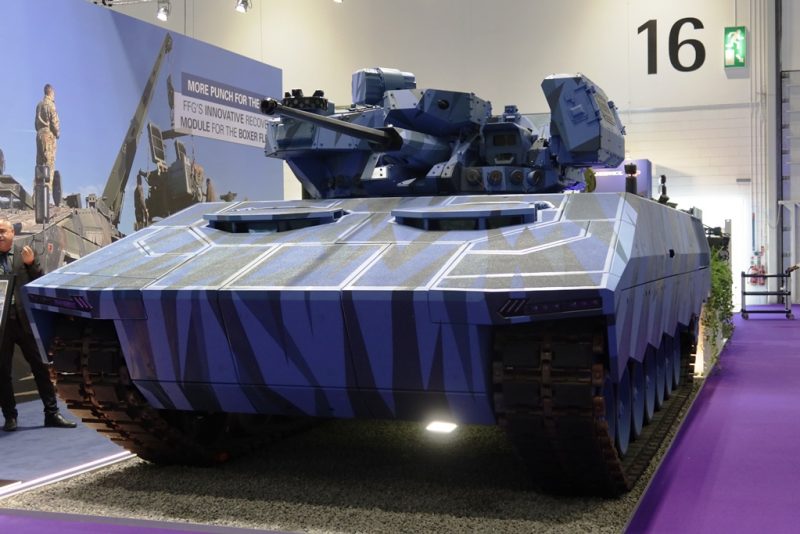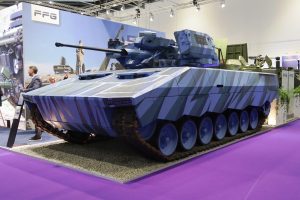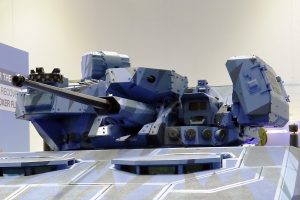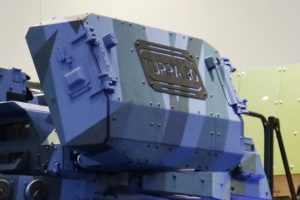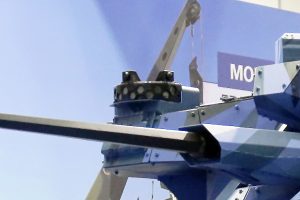DSEI 2025 – FFG showcases its Condor future air defence vehicle
The increasing threat posed by drones and loitering munitions in Ukraine was met with different types of weapon systems, including tube air defence artillery, Cold War era systems such as the German Gepard Flakpanzer. At DSEI FFG Flensburger Fahrzeugbau GmbH, FFG in short, showcased its Condor, a weapon system based on an improved Leopard 1 chassis fitted with a Turra 30 unmanned turret by Czech EVPÚ Defence with sensors provided by IAI Elta of Israel
With the first prototype completed 65 years ago, and the first series tank delivered to the German Army 60 years ago, the Leopard 1 is a legacy platform hard to die. FFG developed a modernisation package that is applied to the Condor mobility platform, the numerous mothballed Leopard 1 MBTs available in the world ensuring a nearly unlimited potential number of refurbishable chassis.
The Condor platform features a new drivetrain, starting from the engine. This is an MTU 8V199TE23, providing up to 1,080 horsepower, a considerable power increase compared to the 830 hp of the Leopard 1A4, provided by the MTU MB 838 10-cylinder engine. While Rolls-Royce, which owns the MTU brand, actively cooperated with FFG for the engine, the same is true for ZF, which cooperated in upgrading the 4HP250 transmission, FFG providing the new two-cycle cooling system. Not only the new engine is more powerful, but it also has a higher maximum torque, while also being lighter (the whole drive unit allows saving 300 kg compared to the original one) and with a smaller volume, freeing space for black boxes which are part of the digitisation package. The MTU 8V199 is also the same engine adopted on the Boxer 8×8 armoured vehicle, which ensures commonality and reduced logistic footprint should an army equipped with the Boxer select the Condor. Compared to the original Leopard 1 the one upgraded by FFG has a new shape while engine exhausts have been relocated, to reduce radar and thermal signature. For the time being the chassis is fitted with steel tracks. Roof and side protection has been improved, and the vehicle is fitted with the FFG digital backbone that allows easy integration of digital subsystems.
The Condor has a crew of three; two hatches are visible at the front of the vehicle, giving access to the driver’s position, to the right, and to the commander’s one, on the left. The gunner’s position is under the turret, and he access the vehicle via a side hatch, located on the left of the chassis.
The turret is provided by EVPÚ Defence, based in Uherské Hradiště, 70 km east of Brno, in the Czech Republic. The one seen at DSEI was the Turra 30 V9, which is the nineth generation of the turret; it is to note that at IDET, the exhibition that took place in Brno in May 2025, EVPU Defence unveiled the Turra 30 V10, the latest iteration of its medium calibre unmanned turret, which was showcased also at MSPO in Kielce, Poland, shortly before DSEI. The Turra 30 V9 part of the Condor SP C-UAS system, is heavily based on the configuration adopted by the Slovak Army, which installed it on the Patria AMV XP 8×8, locally known as BOV (Bojové Obrnené Vozidlo for armoured fighting vehicle). One of the key differences is that the turret in Slovak service is armed with the 30 mm GTS-30/N automatic cannon, in production since 2023 by Slovak ZTS, while the turret proposed at DSEI was armed with the Northrop Grumman Mk 44S Bushmaster II cannon firing 30×173 mm rounds, elevation arc being -10°/+70°; a dual feed weapon capable to fire air burst munitions, on the Condor it has two magazines containing 175 rounds each. Top left of the main gun we find a pod containing the 7.62×51 mm machine gun with 600 read-to-fire rounds.
Further left we find the gunner sight, under which a set of four grenade launchers is fitted, four more being installed on the right side. At the extreme left a missile launcher is fitted, carrying two Rafael Spike LR2 missiles. The EVPU Defence CMS-1 Commander Sight is located on top of the turret, on the right side. And includes a Full HD day channel, a MWIR thermal channel and a laser rangefinder.
IAI Elta of Israel is providing a series of defensive subsystems. Among those we find the Othello optical threat locator, capable to detect incoming gun rounds, mortar rounds, rockets and antitank missiles, each sensor having a 103°x30° field of view, four sensors being needed to cover the whole 360°, day and night; in alternative the Condor can be fitted with the ThunderBullet, which couples optical and acoustic sensors, and has a 180° coverage, hence two systems can cover the entire 360°, and it was this sensor that could be seen installed at the front right and rear left on top of the Turra 30 V9. One of the antennas of the ELM-2135 X-band Drone Guard radar was also visible at the front of the turret on the right, the other three being distributed around the Turra 30. In the V9 configuration seen at DSEI the Turra 30 has a mass between 2.3 and 2.4 tonnes, the aim being to keep the Condor combat mass under 40 tonnes.
EDR On-Line understood that the Turra 30 EV9 had already been fire testes, the whole Condor solution being expected to go to the firing range in early 2026.
As for the Turra 30 V10, this has a combat mass around 3 tonnes and compared to the V9 has a higher profile. The main differences are the adoption of the EVPU Defence Harpia, an AI based active protection system which, according to the company, is capable to defeat incoming missiles as well as UAVs, a multi-canister launcher for Viper drones, bi Lithuanian Baltic Viper, and a comprehensive tactical situational awareness system which includes multi-mission radar, antitank firi8ng detectors, gunshot locator and advanced AI-based algorithms that fuse all those data together providing the crew optimised solutions. EDR On-Line understood that the first firing of the Turra 30 V10 should take place in late 2025.
Photos by P. Valpolini

